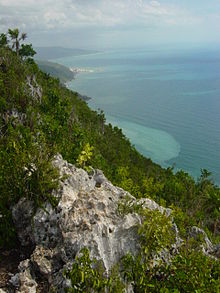Saint Elizabeth Parish
This article needs additional citations for verification. (May 2009) |
Saint Elizabeth | |
|---|---|
 Saint Elizabeth in Jamaica | |
| Country | Jamaica |
| County | Cornwall |
| Capital | Black River |
| Other towns | Santa Cruz, Malvern, Junction, Balaclava, Prospect, Southfield |
| Area | |
| • Total | 1,212.4 km2 (468.1 sq mi) |
| • Rank | 2[2] |
| Population (2012)[3] | |
| • Total | 150,993 |
| • Density | 120/km2 (320/sq mi) |
Saint Elizabeth, one of
, the widest on the island.History
Saint Elizabeth originally included most of the southwest part of the island, but
There are archeological traces of
St Elizabeth became a prosperous parish, and Black River an important seaport. In addition to shipping sugar and molasses, Black River became the centre of the
St Elizabeth was the first parish to have electric power, where it was first introduced in a house called Waterloo in Black River in 1893.
Geography
The parish is located at

The northern and northeastern parts of the parish are
.The main river in the parish is the
The geology of the parish is primarily alluvial plains to the south, and
Demography
The parish had an estimated
In the 19th century Irish, Spanish, Portuguese, Scottish, Germans, Chinese, and East Indians migrated to Saint Elizabeth. There are pockets of ethnic concentrations in the parish, including Mulatto and Creole, notably found in the southeast.
Politics
Saint Elizabeth Parish has four MPs based in four constituencies: Saint Elizabeth North Eastern, Saint Elizabeth North Western, Saint Elizabeth South Eastern and Saint Elizabeth South Western.
Economy
Mining
The parish has been a major producer of bauxite since the 1960s. Port Kaiser, near a town called Alligator Pond, has a leading deep-water pier for bauxite export. The Alpart alumina refinery was constructed in the 1960s at Nain and produces nearly 2 million tonnes of alumina annually for export. The replacement cost of building the refinery is approximately $2 billion.
There are other alumina refineries close to the nearby town of Mandeville.
Agriculture
Apart from
.Tourism
Since the 1990s, the parish has become a significant
Education
The parish has 12 high schools and 75 primary level institutions as well as 167 early childhood institutions.[citation needed] Notable institutions include:
- Bethlehem Moravian College
- Black River High School
- Hampton School
- Lacovia High School
- Munro College
- St. Elizabeth Technical High School
Places
Beaches
- Font Hill Beach
- Galleon, Crane
- Fullerswood
- Parottee
- Fort Charles
- Calabash Bay
- Great Bay
- Billy's Bay
- Frenchman's Bay
- Treasure Beach
- Blue Fields Beach
Towns and villages
The Social Development Commission's national grid of communities has sixty one communities in St. Elizabeth broken down into 465 districts. The communities which include major towns are:
- Aberdeen
- Accompong
- Balaclava
- Ballards Valley
- Barbary Hall
- Bigwoods
- Black River
- Braes River
- Brinkley
- Bogue
- Brompton
- Bull Savanna
- Burnt Savannah
- Carlisle
- Carisbrook
- Cotterwood
- Crawford
- Elderslie
- Exton
- Fairfield
- Fullerswood
- Goshen
- Giddy Hall
- Hodges
- Holland
- Hopewell
- Junction
- Lacovia
- Leeds
- Lititz
- Maggotty
- Malvern
- Merrywood
- Morningside
- Mountainside
- Middle Quarters
- Mulgrave
- Nain
- Newell
- Newton
- Parrottee
- Pepper
- Pedro Plains
- Pondside
- Portsea
- Potsdam
- Quickstep
- Red Bank
- Rose Hall
- Roses Valley
- Rose Hall
- Russells
- Retirement
- Santa Cruz
- Southfield
- Siloah
- Springfield
- Top Hill
- Thornton
- Treasure Beach
- Watchwell
- Williamsfield
- Warminster
- White Hill
Flagaman
Caves
St. Elizabeth has approximately 44 caves, including:
- Mexico
- Peru Cave
- Yhardly Chase Caves
- Wallingford Caves
- Nain
Other places of interest
- lighthousehere too.
- St. Ann.
- Bamboo Avenue in Holland Bamboo was developed in the 17th century when local landowners planted bamboo on both sides of the road to provide shade during their travels.
- Black River is one of the island's largest wetland freshwater ecosystems.[5] Parts of the river can be explored by guided boat trip, where one can experience mangroves, and observe a host of wildlife, including salt water crocodiles, herons, and egrets.
See also
References
Notes
- ^ The title of largest parish in Jamaica has caused some confusion. The parishes of St. Catherine, Saint Elizabeth or St. Ann are usually ranked as the largest, depending on the source. The Gleaner, one of the nations most reputable newspapers, lists St. Catherine as the largest with an area of 1,260 sq km, St. Ann as the second largest with 1200 sq km, and St. Elizabeth third with 1,185 km² (Geography and History of Jamaica. The Jamaica Gleaner. Accessed 9 April 2009). However, The Jamaica Library Service database ranks St Ann the largest with an area of 1212.6 km² (Saint Ann Archived 4 December 2008 at the Wayback Machine. Jamaica Library Services. Accessed 9 April 2009), St. Elizabeth second with 1212.4 km² (St. Elizabeth Archived 4 December 2008 at the Wayback Machine. Jamaica Library Services. Accessed 9 April 2009), and St. Catherine third with 1192.4 km² (Saint Catherine Archived 4 December 2008 at the Wayback Machine. Jamaica Library Services. Accessed 9 April 2009).
- ^ Saint Elizabeth Archived 4 December 2008 at the Wayback Machine. Jamaica Library Services. Accessed 9 April 2009
- ^ "Population by Parish". Statistical Institute of Jamaica. Retrieved 16 September 2015.
- ^ "About Lover's Leap". Archived from the original on 21 October 2009. Retrieved 25 October 2009.
- ^ "Black River Lower Morass | Ramsar Sites Information Service". rsis.ramsar.org. Retrieved 10 October 2022.
Bibliography
- Lover's Leap: Based on the Jamaican Legend, Horane Smith, Minerva Press (1 June 1999), ISBN 0-7541-0589-X
